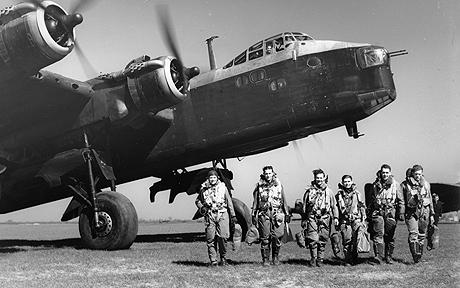The 149 Sqdn left from Lakenheath at 1944-01-28 at 16:47. Loc or duty Gardening
He flew with a Short Stirling (type III, serial EE969, code OJ-E).
Campaign report of the USAAF:
27 January 1944
STRATEGIC OPERATIONS
(Eighth Air Force): Mission 194: 5 of 5 B-17's drop 1.44 million leaflets on Paris, Rennes, Le Mans and Orleans, France without loss.
TACTICAL OPERATIONS
(Ninth Air Force): 572d Bombardment Squadron (Medium), 391st Bombardment Group (Medium), arrives at Matching, England from the US with B-26's; first mission is 15 Feb.
28 January 1944
STRATEGIC OPERATIONS
(Eighth Air Force): Mission 195: 54 B-24's in 2 groups are dispatched to the Bonnieres V-weapon site in France; 2 Gee-H equipped PFF aircraft lead each group; due to technical difficulties, the second formation was ordered to follow the lead and bomb the same target as a secondary; 4 minutes before the target the leader of one section accidentally released and the following 11 aircraft did likewise; 31 hit the primary; 1 B-24 is damaged. 122 P-47's provide escort without loss.
Gee-H is more accurate than H2X but is of use only against targets within the 200-mi (320 km) beacon range; later, aircraft are equipped with both devices.
Mission 196: During the evening, 5 of 5 B-17's drop 1.36 million leaflets on Amiens, Rouen, Cambrai, Reims and Caen, France without loss.
Mission 197: During the night, 1 B-17 on an Oboe Mk II test drops 2 tons of bombs on Emmerich, Germany. 748th, 749th, 750th and 751st Bombardment Squadrons (Heavy), 457th Bombardment Group (Heavy), arrive at Glatton, England from the US with B-17's; first mission is 21 Feb.
Campaign report of the RAF:
27/28 January 1944
515 Lancasters and 15 Mosquitos despatched to Berlin. The German fighters were committed to action earlier than normal, some being sent out 75 miles over the North Sea from the Dutch coast. A number of elaborate feints and diversions had some effect; Half of the German fighters were lured north by the Heligoland mining diversion and action in the main bomber stream was less intense than on recent nights. 33 Lancasters lost, 6.4 per cent of the heavy force. The target was cloud-covered again and skymarking had to be used. Bomber Command was not able to make any assessment of the raid except to state that the bombing appeared to have been spread well up and down wind.
Extensive operations were carried out in support of the Berlin raid. 80 Stirlings and Wellingtons flew to the Dutch coast and laid mines there, 21 Halifaxes did the same near Heligoland, both hoping to draw the German fighters up early. 9 aircraft flew RCM sorties and 12 Mosquitos flew Serrate patrols. 18 Mosquito-bomber aircraft dropped imitation 'fighter flares' away from the main bomber routes to and from the target. 140 aircraft were thus engaged in various operations in support of the main raid. 1 Stirling minelayer lost.
9 Mosquitos bombed a flying-bomb site at Herbouville, 8 Halifaxes flew Resistance operations sorties, 10 OTU aircraft dropped leaflets over France. No aircraft lost.
Total effort for the night: 697 sorties, 34 aircraft (4.9 per cent) lost.
28/29 January 1944
Berlin: 677 aircraft - 432 Lancasters, 241 Halifaxes, 4 Mosquitos. Part of the German fighter force was drawn up by the early diversions and the bomber approach route over Northern Denmark proved too distant for some of the other German fighters. The German controller was, however, able to concentrate his fighters over the target and many aircraft were shot down there. 46 aircraft - 26 Halifaxes, 20 Lancasters - lost, 6.8 per cent of the force. The cloud over Berlin was broken and some ground-marking was possible but the Bomber Command claim that this was the most concentrated attack of this period is not quite fully confirmed by German records. The western and southern districts were hit but so too were 77 places outside the city.
63 Stirlings and 4 Pathfinder Halifaxes carried out minelaying in Kiel Bay 5 hours before the main Berlin operation; this was the first time that Pathfinder aircraft helped a minelaying operation. 6 Mosquitos bombed Berlin 4 hours before the main attack and 18 Mosquitos bombed night-fighter airfields at Deelen, Leeuwarden and Venlo. 4 Mosquitos carried out a diversionary raid to Hannover and 6 more Mosquitos flew Serrate patrols at the same time as the main raid. 2 Stirling minelayers and 1 Serrate Mosquito were lost from these operations. 16 OTU Wellingtons carried out leaflet flights to France without loss.
Total effort for the night: 794 sorties, 49 aircraft (6.2 per cent) lost.
With thanks to the RAF and USAAF.net!
This record can also be found on the maps of Back to Normandy with Google coordinates. You can find the maps by clicking on this link on this location.
There are several possibilities to investigate the flight records on Back to Normandy. All the flights are plotted on maps, sorted "day by day", "by squadron", "by type aircraft", "by year or month", "by location" and much more! Don't miss this!!!
If you have any information that you want to share, please add your comment at the bottom of this record. Or send your information to [email protected]. This information will be added to the record.
Your photos and your information are very welcome! The young do care and with your help we keep up the good work.



